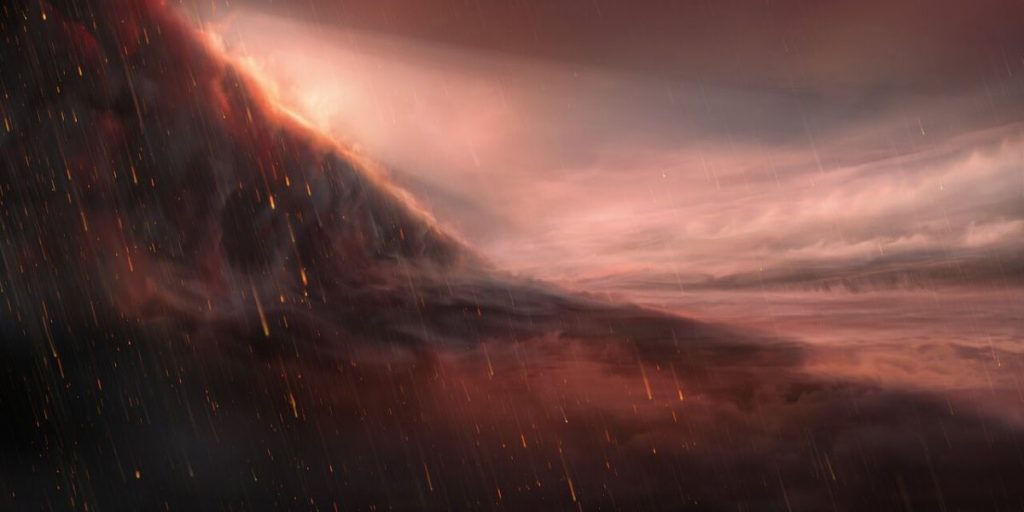
James Webb Space Telescope will seek clouds of vaporized gems on exoplanets (Image Credit: Space.com)
Astronomers will be hoping for cloudy skies as the James Webb Space Telescope (JWST or Webb) turns its attention to exoplanetary atmospheres laden with vaporized rock and crystals such as corundum and perovskite, which form gems on Earth.
Hot Jupiters, which are gas giants that orbit extremely close to their stars, grow so hot that rocky elements, minerals and metals can exist as vapor in their atmospheres, scorched by temperatures as great as 3,600 degrees Fahrenheit (2,000 degrees Celsius).
“On Earth, a lot of these minerals are jewels,” Tiffany Kataria, who is an exoplanetary scientist at NASA’s Jet Propulsion Laboratory, said in a statement. “A geologist would study them as rocks on Earth, but they can form clouds on exoplanets. That’s pretty wild.”
Related: These 10 super extreme exoplanets are out of this world
Such minerals have been detected in the atmospheres of exoplanets before. In 2017 astronomers using the Very Large Telescope (VLT) at the European Southern Observatory in Chile detected the signature of titanium oxide in the atmosphere of a hot Jupiter called WASP-19b. Three years later, the VLT observed iron vapor on the day-side of the hot Jupiter WASP-76b.
Many hot Jupiters are tidally locked, meaning that they always show the same face to their star, which leads to their daysides becoming incredibly hot. In the case of WASP-76b, the dayside reaches a scorching 4,000 degrees F (2,200 degrees C). The planet’s night-side is ‘only’ 2,700 degrees F (1,500 degrees C), but that’s cool enough for iron to condense and precipitate out as a rain of molten metal.
Previously, these elements and minerals have been detected as a diffuse presence in exoplanetary atmospheres. Now, JWST’s high-resolution vision will be able to directly distinguish these minerals as clouds, spectroscopically measuring their composition.
“Clouds tell us a lot about the chemistry in the atmosphere,” Kataria said. “It then becomes a question of how the clouds formed, and the formation and evolution of the system as a whole.”

For example, on WASP-19b the titanium oxide absorbs heat, causing a temperature inversion whereby the planet’s upper atmosphere is hotter than the lower atmosphere, where the reverse would normally be expected.
JWST has already observed alien atmospheres, detecting water clouds in the atmosphere of the exoplanet WASP-96b, where scientists previously thought there were no clouds at all. During its first year of observations, JWST is investigating a multitude of other exoplanet atmospheres, too.
Kataria herself is involved in a number of projects, including teaming up with Thomas Mikal-Evans of MIT to use JWST’s Near Infrared Spectrometer (NIRSpec) to characterize the atmosphere of the ultra-hot Jupiter WASP-121b, which is 850 light-years away from Earth and which was the first exoplanet to be found to possess a watery stratosphere.
Another of Kataria’s projects with JWST is to observe the hot Jupiter HD 80606b, which is 290 light-years from Earth and is on a highly eccentric orbit that loops around its star, bringing it as close as 2.8 million miles (4.5 million kilometers) and taking it as far as 81 miles (131 million km). As a result, HD 80606b experiences ‘flash heating’ when its temperature rises from 930 degrees F (500 degrees C) to 2,200 degrees F (1,200 degrees C) in a matter of hours as it speeds close to its star. The effect on the planet’s weather is staggering, with computer models predicting violent storms and winds raging at 15 times the speed of sound; Kataria hopes that JWST will be able to observe these events.

Finally, Kataria is co-leading a project along with Brian Kilpatrick of the Space Telescope Science Institute in Baltimore to create 3D ‘eclipse maps’ of the exoplanet HD 189733b with JWST’s Mid-Infrared Instrument (MIRI). Eclipse maps are made when a planet moves behind its star. By subtracting the faint signature of the planet’s light from the star’s light as the planet moves into eclipse, scientists can isolate the planet’s light and map the temperature of its atmosphere. Kataria and Kilpatrick hope the technique will allow them to determine the most accurate circulation model yet for an exoplanet’s atmosphere.
This exoplanet, which is 64.5 light-years away from Earth, was discovered in 2005 and has since become one of the best studied hot Jupiters. Several other projects will also observe HD 189733b with JWST, including an effort to perform a deep survey of the molecular composition of the planet’s atmosphere and determine the composition of any clouds present, as well as an effort to search for aerosols of vaporized minerals that form clouds in HD 189733b’s atmosphere.
The atmospheres of smaller, rocky exoplanets will also come under scrutiny from JWST. Researchers will measure the composition of the atmosphere on 55 Cancri e, which is a super-Earth with eight times the mass of our planet; scientists also hope to determine whether it is hot enough to rain lava. And the seven worlds of the TRAPPIST-1 system will also come under scrutiny, with JWST surveying each planet in the system for an atmosphere.
Astronomers will pay particularly close attention to TRAPPIST-1e, which is the most Earth-like planet in the neighborhood. If it is habitable, then evidence for that may be found in its atmosphere, including in its clouds.
“Clouds are an important feature on Earth, to regulate temperature,” Kataria said. “They’re an important consideration for Earth’s climate. It stands to reason that clouds could also be a vital component in the atmosphere of a habitable exoplanet. The more we understand how clouds form in general — as they have on Earth and other solar system planets — the more we understand how clouds evolved in more exotic environments.”
Follow Keith Cooper on Twitter @21stCenturySETI. Follow us on Twitter @Spacedotcom and on Facebook.





